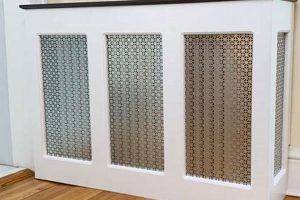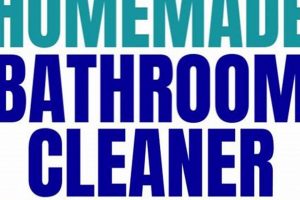A do-it-yourself scalp exfoliant involves the creation and application of a homemade treatment designed to remove dead skin cells, excess oil, and product buildup from the scalp. This process often utilizes readily available ingredients and is formulated to promote a cleaner, healthier scalp environment. For example, a mixture of sugar, olive oil, and essential oils can serve as an effective homemade exfoliant.
The practice of scalp exfoliation is valued for its potential to improve scalp health, encourage hair growth, and alleviate conditions such as dandruff and itchy scalp. Historically, various cultures have incorporated scalp treatments using natural ingredients to maintain hygiene and promote overall well-being. Regular exfoliation can enhance blood circulation in the scalp, potentially stimulating hair follicles and promoting stronger hair growth.
Subsequent sections will explore specific recipes for these homemade scalp treatments, detail application techniques, and discuss considerations for different hair and scalp types to ensure safe and effective implementation.
Essential Considerations for Homemade Scalp Exfoliants
Achieving optimal results with homemade scalp treatments requires careful consideration of several key factors. The following guidelines outline best practices for creating and utilizing these formulations effectively.
Tip 1: Ingredient Selection. Prioritize natural and gentle ingredients. Sugar, salt, and ground oats serve as effective physical exfoliants. Oils such as coconut, olive, and jojoba provide moisturizing benefits. Essential oils, used sparingly, can offer therapeutic properties. Research individual ingredient sensitivities before use.
Tip 2: Formulation Consistency. Aim for a paste-like consistency that is neither too runny nor too thick. An overly liquid mixture will be difficult to apply, while an excessively thick concoction can be challenging to rinse out completely. Adjust liquid and solid ingredients accordingly.
Tip 3: Application Technique. Part the hair into sections to ensure even distribution of the exfoliant across the scalp. Gently massage the mixture into the scalp using fingertips, avoiding harsh scrubbing that can cause irritation. Focus on areas prone to buildup or dryness.
Tip 4: Duration of Treatment. Allow the exfoliant to remain on the scalp for approximately 5-10 minutes. Extended exposure can lead to irritation or dryness, particularly for individuals with sensitive skin. Adherence to the recommended duration is crucial.
Tip 5: Thorough Rinsing. Rinse the hair and scalp thoroughly with lukewarm water until all traces of the exfoliant are removed. Residual exfoliant can cause itching or flaking. Multiple rinses may be necessary to ensure complete removal.
Tip 6: Frequency of Use. Limit the frequency of exfoliation to once or twice per week. Over-exfoliation can strip the scalp of its natural oils, leading to dryness, irritation, and potential damage to hair follicles. Adjust frequency based on individual scalp needs and tolerance.
Tip 7: Patch Testing. Conduct a patch test on a small area of skin, such as the inner arm, 24 hours prior to applying the exfoliant to the entire scalp. This will help identify any potential allergic reactions or sensitivities to the ingredients used. Discontinue use immediately if irritation occurs.
These considerations emphasize the importance of a cautious and informed approach to scalp exfoliation. Consistent application of these principles will help maximize benefits while minimizing potential adverse effects.
The succeeding section will present specific recipes, focusing on the practical application of these guidelines and providing customizable options for diverse scalp conditions.
1. Exfoliation effectiveness
The effectiveness of exfoliation directly correlates with the design and application of a do-it-yourself scalp scrub. A scrub’s ability to physically remove dead skin cells, excess sebum, and product residue is paramount. Insufficient exfoliation renders the scrub ineffective, failing to alleviate conditions such as dandruff or promote a healthy scalp environment. Conversely, overly aggressive exfoliation can damage the scalp, leading to irritation and inflammation. The selection of appropriate abrasive agents, such as finely ground sugar or salt, and the modulation of application pressure are critical factors influencing efficacy. For example, a scrub with coarse salt applied vigorously to a sensitive scalp may cause micro-abrasions, negating any potential benefits.
Formulation and technique further determine the exfoliation effectiveness. A well-formulated scrub incorporates emollients to soften the skin and facilitate the removal of debris. Similarly, correct application technique, involving gentle massage rather than harsh scrubbing, optimizes the removal process while minimizing potential harm. Consider a scrub composed solely of an abrasive agent without any moisturizing component; such a formulation might effectively remove debris but leave the scalp excessively dry and irritated, thereby undermining its overall effectiveness. Consistent and proper application, coupled with an appropriate formulation, is essential for achieving the desired exfoliation effect.
In summary, exfoliation effectiveness within the context of homemade scalp treatments is dependent on a delicate balance between the abrasive properties of the scrub, the gentleness of its application, and the inclusion of soothing and hydrating ingredients. The key insight is that maximal benefit is achieved through a balanced approach that prioritizes both effective cleansing and scalp health. Challenges arise in determining the ideal balance for individual scalp types and conditions, necessitating careful observation and adjustment of the formulation and application technique.
2. Ingredient compatibility
Ingredient compatibility is a critical factor determining the efficacy and safety of do-it-yourself scalp exfoliants. The interaction of different components within a homemade formulation can significantly impact its overall performance and the potential for adverse reactions on the scalp.
- pH Balance Maintenance
The pH level of ingredients must be considered to avoid disrupting the scalp’s natural acid mantle. An imbalance can lead to irritation, dryness, or increased susceptibility to microbial growth. For instance, combining a highly acidic ingredient like lemon juice (pH ~2) with an alkaline component without proper buffering can shift the scalp’s pH, potentially causing damage.
- Solubility and Dispersion
Ensuring proper solubility and dispersion of ingredients is essential for even distribution and effectiveness of the scrub. If components do not mix well, the exfoliating action may be uneven, and certain areas of the scalp cou
ld be over- or under-treated. Oil-based and water-based ingredients may require an emulsifier to ensure uniform dispersion and prevent separation. - Synergistic or Antagonistic Effects
Certain ingredient combinations may exhibit synergistic benefits, enhancing each other’s properties. Conversely, antagonistic interactions can neutralize desired effects or create undesirable outcomes. For example, combining tea tree oil (an antiseptic) with a carrier oil that clogs pores would negate the antiseptic benefits and potentially cause breakouts on the scalp.
- Allergenic Potential
The allergenic potential of individual ingredients and their combinations must be carefully evaluated, particularly for individuals with sensitive skin. A component harmless on its own might trigger a reaction when combined with another ingredient. Patch testing is imperative to identify any adverse reactions before widespread application.
Successful creation of a homemade scalp exfoliant hinges on a thorough understanding of ingredient compatibility. Selecting components that work harmoniously, maintain the scalp’s pH, disperse evenly, and minimize allergenic potential is crucial. Careful consideration of these factors contributes significantly to the safety and effectiveness of the do-it-yourself process.
3. Scalp stimulation
Scalp stimulation, achieved through mechanical or chemical means, plays a vital role in maximizing the benefits derived from do-it-yourself scalp scrubs. The interaction between manual massage during scrub application and the formulation’s active ingredients creates an environment conducive to improved scalp health.
- Enhanced Blood Circulation
Manual massage, integral to the application of a homemade scalp treatment, directly increases blood flow to the scalp. Enhanced circulation delivers more oxygen and nutrients to hair follicles, potentially promoting hair growth and strengthening existing strands. For example, consistent, gentle massage during the application of a sugar-based scrub can improve circulation compared to simply applying the scrub without massage. This increased blood flow can also aid in the removal of metabolic waste products from the scalp tissue.
- Follicle Activation
Physical manipulation of the scalp during scrub application stimulates hair follicles. This stimulation can help to awaken dormant follicles and encourage them to enter the active growth phase. Certain ingredients, like caffeine or rosemary oil, can further enhance this effect. The follicle activation process can be particularly beneficial for individuals experiencing thinning hair or slowed hair growth. Regularly stimulating the follicles with a gentle scrub can contribute to a fuller, healthier head of hair over time.
- Product Penetration
Stimulation of the scalp during exfoliation can improve the penetration of beneficial ingredients present in the formulation. Massaging the scrub into the scalp loosens dead skin cells and opens pores, allowing active components like essential oils or vitamins to reach the hair follicles more effectively. This enhanced absorption can lead to greater therapeutic benefits compared to simply applying the ingredients topically. The result is an amplified effect from the intended purpose of the do-it-yourself product.
- Stress Reduction
Scalp massage, a key aspect of utilizing these scrubs, offers a stress-relieving effect. The act of massaging the scalp promotes relaxation, reducing tension and potentially mitigating the negative effects of stress on hair health. For example, individuals experiencing stress-related hair loss may find that incorporating regular scalp massage into their haircare routine, in conjunction with a gentle exfoliating scrub, can help to counterbalance the physiological impacts of stress on hair follicles.
In conclusion, the inclusion of scalp stimulation within the application of do-it-yourself scalp treatments extends beyond mere cleansing. The combined effects of increased circulation, follicle activation, enhanced product penetration, and stress reduction contribute to a holistic approach to scalp health. While the specific benefits may vary depending on individual factors and the chosen formulation, the principle of scalp stimulation remains a critical element in optimizing the efficacy of these homemade haircare practices.
4. Residue removal
Residue removal is an integral component of effectively using a do-it-yourself scalp scrub. The primary purpose of a scrub is to eliminate accumulated dead skin cells, excess sebum, and lingering hair product residue. Inadequate removal of these substances can negate the benefits of the exfoliation process, leading to potential scalp irritation and hindering optimal hair follicle function.
- Clogging Prevention
The accumulation of residue, including silicone-based hair products, can physically block hair follicles. This blockage inhibits the natural shedding of hair and can contribute to inflammation. A properly executed scrub, followed by thorough rinsing, ensures the follicles remain unobstructed, allowing for healthy hair growth. For example, if a homemade scrub is formulated with oil and sugar but not thoroughly rinsed, the residual oil can trap dead skin cells, exacerbating the problem it was intended to solve.
- Microbial Growth Control
Residue, particularly sebum mixed with dead skin cells, provides a breeding ground for microorganisms, including bacteria and fungi. These organisms can contribute to conditions such as dandruff, seborrheic dermatitis, and folliculitis. Effective residue removal minimizes the availability of nutrients that support microbial proliferation, reducing the risk of scalp infections. A scrub containing antimicrobial ingredients, like tea tree oil, is only effective if the loosened residue is completely rinsed away.
- Product Absorption Enhancement
A clean scalp, devoid of residue, facilitates the absorption of subsequent haircare products, such as serums, oils, and conditioners. If residue remains on the scalp, it creates a barrier that prevents these products from penetrating the hair follicles and scalp tissue, reducing their efficacy. Therefore, the benefit of applying a nourishing hair mask is diminished if the scalp is not thoroughly cleansed with a scrub beforehand.
- Itch and Irritation Reduction
Residual scrub components, particularly abrasive particles or irritating ingredients, can cause persistent itchiness and irritation. Insufficient rinsing leaves behind these irritants, prolonging discomfort and potentially leading to skin inflammation. For example, using a scrub containing finely ground nut shells without ensuring complete removal can result in microscopic scratches and persistent irritation.
The success of a do-it-yourself scalp exfoliation hinges on meticulously removing loosened residue. Insufficient rinsing after the scrub application can reverse its intended benefits, leading to clogged follicles, microbial growth, impaired product absorption, and scalp irritation. Comprehensive residue removal is, therefore, a critical step in maintaining a healthy scalp and optimizing hair growth.
5. Hydration balance
Hydration balance represents a critical factor in the formulation and application of do-it-yourself scalp scrubs. While the primary function of these scrubs is to exfoliate and remove excess oil and debris, the process can inadvertently strip the scalp of its natural moisture. This disruption of the scalp’s natural lipid barrier can lead to dryness, irritation, and even exacerbate conditions such as dandruff. A well-designed homemade scrub must, therefore, incorporate hydrating ingredients to counteract the potential drying effects of exfoliation.
The inclusion of oils, such as coconut oil, olive oil, or jojoba oil, in a do-it-yourself scalp scrub serves to replenish lost moisture and maintain the scalp’s hydration level. These oils possess emollient properties, which soften the skin and reduce water loss. For example, a scrub consisting solely of salt and water, while effective at exfoliation, will likely leave the scalp feeling dry and tight. Conversely, a scrub incorporating a carrier oil alongside the salt can provide both exfoliation and hydration simultaneously, minimizing the risk of dryness. The selection of specific oils should consider individual scalp conditions. A lighter oil like jojoba might be more suitable for oily scalps, while a richer oil like shea butter might be beneficial for dry scalps.
Maintaining hydration balance in a homemade scalp scrub is not merely about preventing dryness; it’s about fostering a healthy scalp environment conducive to optimal hair growth. An overly dry scalp can become inflamed and irritated, potentially hindering hair follicle function. By carefully selecting and incorporating hydrating ingredients, a do-it-yourself scalp scrub can effectively cleanse and exfoliate while preserving the scalp’s natural moisture, promoting a healthier scalp and, consequently, healthier hair. The challenge lies in achieving the right balance, as excessive oiliness can also contribute to scalp problems. The ideal formulation is one that effectively cleanses without disrupting the scalp’s natural moisture balance, thereby promoting a healthy environment for hair growth.
6. Frequency moderation
Frequency moderation is a critical determinant of the success and safety of any do-it-yourself scalp scrub regimen. Over-exfoliation, stemming from excessive frequency, can disrupt the scalp’s natural lipid barrier, leading to dehydration, irritation, and potential inflammation. The intended benefit of removing dead skin cells and product buildup is negated when the scalp’s protective mechanisms are compromised. For instance, a weekly scrub, beneficial for individuals with oily scalps, may prove detrimental if applied daily, resulting in a dry, itchy, and inflamed scalp. Conversely, insufficient frequency may fail to address underlying scalp issues, rendering the do-it-yourself treatment ineffective. An individual with a seborrheic dermatitis condition who only uses a scrub once a month may not experience any significant improvement in their condition.
The optimal frequency of a scalp scrub is contingent upon several factors, including scalp type (oily, dry, sensitive, normal), hair type (fine, coarse, treated, untreated), and the specific ingredients used in the scrub. A scrub containing potent exfoliants, such as high concentrations of salt or chemical exfoliants like salicylic acid, necessitates less frequent application than a gentler formulation with finely ground oats and moisturizing oils. Furthermore, individuals with pre-existing scalp conditions, such as eczema or psoriasis, require cautious moderation and may need to consult a dermatologist before incorporating a do-it-yourself scrub into their routine. Careful observation of the scalp’s response is paramount; signs of irritation, redness, or increased dryness indicate the need to reduce the frequency of application.
In summary, frequency moderation is not merely a secondary consideration but rather an essential component of responsible do-it-yourself scalp scrub use. The optimal frequency strikes a balance between effective exfoliation and the preservation of the scalp’s natural health. Challenges arise in determining the ideal frequency for each individual, requiring careful assessment of scalp type, formulation ingredients, and the scalp’s reaction to the treatment. Understanding the importance of frequency moderation links directly to the broader theme of responsible and informed self-care practices, ensuring that do-it-yourself treatments enhance, rather than harm, scalp health.
Frequently Asked Questions Regarding Do-It-Yourself Scalp Exfoliants
This section addresses common inquiries and misconceptions associated with the utilization of homemade scalp treatments. The information presented aims to provide clarity and promote informed decision-making.
Question 1: Are do-it-yourself scalp scrubs suitable for all hair types?
The suitability of a homemade scalp treatment depends on the specific formulation and the individual’s scalp condition. Individuals with sensitive scalps should exercise caution and perform a patch test prior to full application. Adjustments to the ingredients may be necessary to accommodate different hair and scalp types.
Question 2: How frequently should a do-it-yourself scalp scrub be used?
The recommended frequency varies based on individual scalp conditions and hair type. Generally, once or twice per week is adequate for most individuals. Over-exfoliation can lead to irritation and dryness. Observation of the scalp’s response is crucial in determining the optimal frequency.
Question 3: Can do-it-yourself scalp scrubs promote hair growth?
While direct causation is not definitively established, scalp exfoliation can improve scalp health by removing dead skin cells and promoting circulation. A healthy scalp environment is conducive to optimal hair follicle function, which may indirectly support hair growth.
Question 4: What ingredients should be avoided in a do-it-yourself scalp scrub?
Harsh abrasives, such as large salt crystals or nut shells, should be avoided due to the potential for causing micro-abrasions on the scalp. Ingredients with known allergens should also be excluded. Essential oils should be used sparingly and with caution.
Question 5: How should a do-it-yourself scalp scrub be applied?
Part the hair into sections and apply the scrub directly to the scalp. Gently massage the scrub in a circular motion, focusing on areas with buildup or dryness. Avoid harsh scrubbing. Rinse thoroughly with lukewarm water to remove all traces of the scrub.
Question 6: What are the potential risks associated with using do-it-yourself scalp scrubs?
Potential risks include scalp irritation, dryness, allergic reactions, and folliculitis. These risks can be minimized by carefully selecting ingredients, performing patch tests, and avoiding over-exfoliation. Discontinue use if any adverse reactions occur.
Key takeaways emphasize the importance of careful ingredient selection, proper application technique, and moderate frequency when utilizing homemade scalp treatments. Observation of individual scalp responses is crucial for ensuring safety and efficacy.
The subsequent section will explore advanced techniques for addressing specific scalp conditions using specialized do-it-yourself exfoliant formulations.
DIY Scalp Scrub
This exploration has elucidated critical aspects of the do-it-yourself scalp scrub. From the careful selection of compatible ingredients to the significance of frequency moderation and thorough residue removal, each element contributes to the treatment’s potential efficacy and safety. The enhancement of blood circulation, achieved through gentle massage, complements the exfoliation process. Hydration balance, meticulously maintained through appropriate formulations, ensures the preservation of the scalps natural protective barrier.
The application of a homemade scalp exfoliant warrants a conscientious approach. Individual scalp conditions necessitate tailored formulations and judicious application frequencies. Prioritizing scalp health requires consistent observation and adjustment, fostering a responsible approach that maximizes benefits while mitigating potential adverse effects. Further research into the nuanced interactions between specific ingredients and scalp conditions remains essential for advancing the understanding and responsible utilization of do-it-yourself scalp treatments.






![DIY Build: Circular Saw Crosscut Jig PDF Plans [Free] The DIY Hub: Creative Crafts, Repairs & Life Hacks DIY Build: Circular Saw Crosscut Jig PDF Plans [Free] | The DIY Hub: Creative Crafts, Repairs & Life Hacks](https://craftingdiycenter.com/wp-content/uploads/2025/07/th-5916-300x200.jpg)
